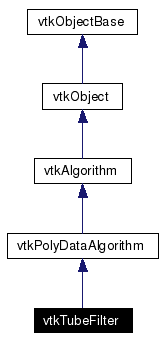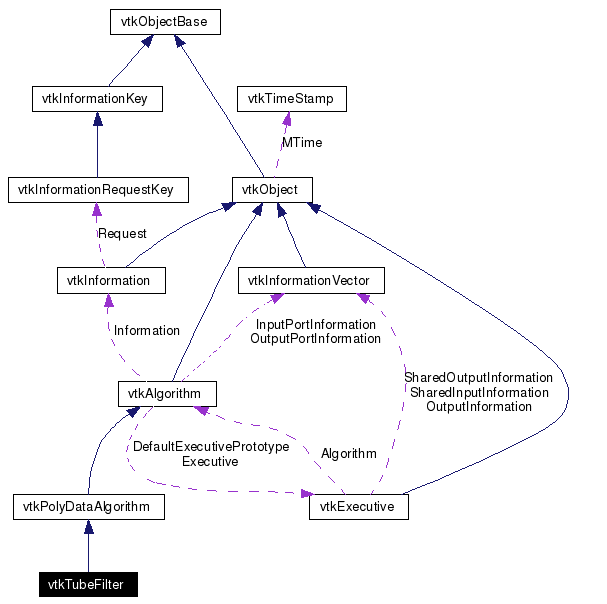
#include <vtkTubeFilter.h>
Inheritance diagram for vtkTubeFilter:


vtkTubeFilter is a filter that generates a tube around each input line. The tubes are made up of triangle strips and rotate around the tube with the rotation of the line normals. (If no normals are present, they are computed automatically.) The radius of the tube can be set to vary with scalar or vector value. If the radius varies with scalar value the radius is linearly adjusted. If the radius varies with vector value, a mass flux preserving variation is used. The number of sides for the tube also can be specified. You can also specify which of the sides are visible. This is useful for generating interesting striping effects. Other options include the ability to cap the tube and generate texture coordinates. Texture coordinates can be used with an associated texture map to create interesting effects such as marking the tube with stripes corresponding to length or time.
This filter is typically used to create thick or dramatic lines. Another common use is to combine this filter with vtkStreamLine to generate streamtubes.
The input line must not have duplicate points, or normals at points that are parallel to the incoming/outgoing line segments. (Duplicate points can be removed with vtkCleanPolyData.) If a line does not meet this criteria, then that line is not tubed.
Definition at line 81 of file vtkTubeFilter.h.
|
|
Reimplemented from vtkPolyDataAlgorithm. Definition at line 84 of file vtkTubeFilter.h. |
|
|
|
|
|
Definition at line 204 of file vtkTubeFilter.h. |
|
|
Reimplemented from vtkPolyDataAlgorithm. |
|
|
Return 1 if this class type is the same type of (or a subclass of) the named class. Returns 0 otherwise. This method works in combination with vtkTypeRevisionMacro found in vtkSetGet.h. Reimplemented from vtkPolyDataAlgorithm. |
|
|
Return 1 if this class is the same type of (or a subclass of) the named class. Returns 0 otherwise. This method works in combination with vtkTypeRevisionMacro found in vtkSetGet.h. Reimplemented from vtkPolyDataAlgorithm. |
|
|
Reimplemented from vtkPolyDataAlgorithm. |
|
||||||||||||
|
Methods invoked by print to print information about the object including superclasses. Typically not called by the user (use Print() instead) but used in the hierarchical print process to combine the output of several classes. Reimplemented from vtkPolyDataAlgorithm. |
|
|
Construct object with radius 0.5, radius variation turned off, the number of sides set to 3, and radius factor of 10. Reimplemented from vtkPolyDataAlgorithm. |
|
|
Set the minimum tube radius (minimum because the tube radius may vary). |
|
|
Set the minimum tube radius (minimum because the tube radius may vary). |
|
|
Turn on/off the variation of tube radius with scalar value. |
|
|
Turn on/off the variation of tube radius with scalar value. |
|
|
Turn on/off the variation of tube radius with scalar value. Definition at line 103 of file vtkTubeFilter.h. References VTK_VARY_RADIUS_OFF. |
|
|
Turn on/off the variation of tube radius with scalar value. Definition at line 105 of file vtkTubeFilter.h. References VTK_VARY_RADIUS_BY_SCALAR. |
|
|
Turn on/off the variation of tube radius with scalar value. Definition at line 107 of file vtkTubeFilter.h. References VTK_VARY_RADIUS_BY_VECTOR. |
|
|
Turn on/off the variation of tube radius with scalar value. Definition at line 109 of file vtkTubeFilter.h. References VTK_VARY_RADIUS_BY_ABSOLUTE_SCALAR. |
|
|
Turn on/off the variation of tube radius with scalar value. |
|
|
Set the number of sides for the tube. At a minimum, number of sides is 3. |
|
|
Set the number of sides for the tube. At a minimum, number of sides is 3. |
|
|
Set the maximum tube radius in terms of a multiple of the minimum radius. |
|
|
Set the maximum tube radius in terms of a multiple of the minimum radius. |
|
||||||||||||||||
|
Set the default normal to use if no normals are supplied, and the DefaultNormalOn is set. |
|
|
Set the default normal to use if no normals are supplied, and the DefaultNormalOn is set. |
|
|
Set the default normal to use if no normals are supplied, and the DefaultNormalOn is set. |
|
|
Set the default normal to use if no normals are supplied, and the DefaultNormalOn is set. |
|
|
Set a boolean to control whether to use default normals. DefaultNormalOn is set. |
|
|
Set a boolean to control whether to use default normals. DefaultNormalOn is set. |
|
|
Set a boolean to control whether to use default normals. DefaultNormalOn is set. |
|
|
Set a boolean to control whether to use default normals. DefaultNormalOn is set. |
|
|
Set a boolean to control whether tube sides should share vertices. This creates independent strips, with constant normals so the tube is always faceted in appearance. |
|
|
Set a boolean to control whether tube sides should share vertices. This creates independent strips, with constant normals so the tube is always faceted in appearance. |
|
|
Set a boolean to control whether tube sides should share vertices. This creates independent strips, with constant normals so the tube is always faceted in appearance. |
|
|
Set a boolean to control whether tube sides should share vertices. This creates independent strips, with constant normals so the tube is always faceted in appearance. |
|
|
Turn on/off whether to cap the ends with polygons. |
|
|
Turn on/off whether to cap the ends with polygons. |
|
|
Turn on/off whether to cap the ends with polygons. |
|
|
Turn on/off whether to cap the ends with polygons. |
|
|
Control the striping of the tubes. If OnRatio is greater than 1, then every nth tube side is turned on, beginning with the Offset side. |
|
|
Control the striping of the tubes. If OnRatio is greater than 1, then every nth tube side is turned on, beginning with the Offset side. |
|
|
Control the striping of the tubes. The offset sets the first tube side that is visible. Offset is generally used with OnRatio to create nifty striping effects. |
|
|
Control the striping of the tubes. The offset sets the first tube side that is visible. Offset is generally used with OnRatio to create nifty striping effects. |
|
|
Control whether and how texture coordinates are produced. This is useful for striping the tube with length textures, etc. If you use scalars to create the texture, the scalars are assumed to be monotonically increasing (or decreasing). |
|
|
Control whether and how texture coordinates are produced. This is useful for striping the tube with length textures, etc. If you use scalars to create the texture, the scalars are assumed to be monotonically increasing (or decreasing). |
|
|
Control whether and how texture coordinates are produced. This is useful for striping the tube with length textures, etc. If you use scalars to create the texture, the scalars are assumed to be monotonically increasing (or decreasing). Definition at line 182 of file vtkTubeFilter.h. References VTK_TCOORDS_OFF. |
|
|
Control whether and how texture coordinates are produced. This is useful for striping the tube with length textures, etc. If you use scalars to create the texture, the scalars are assumed to be monotonically increasing (or decreasing). Definition at line 184 of file vtkTubeFilter.h. References VTK_TCOORDS_FROM_NORMALIZED_LENGTH. |
|
|
Control whether and how texture coordinates are produced. This is useful for striping the tube with length textures, etc. If you use scalars to create the texture, the scalars are assumed to be monotonically increasing (or decreasing). Definition at line 186 of file vtkTubeFilter.h. References VTK_TCOORDS_FROM_LENGTH. |
|
|
Control whether and how texture coordinates are produced. This is useful for striping the tube with length textures, etc. If you use scalars to create the texture, the scalars are assumed to be monotonically increasing (or decreasing). Definition at line 188 of file vtkTubeFilter.h. References VTK_TCOORDS_FROM_SCALARS. |
|
|
Control whether and how texture coordinates are produced. This is useful for striping the tube with length textures, etc. If you use scalars to create the texture, the scalars are assumed to be monotonically increasing (or decreasing). |
|
|
Control the conversion of units during the texture coordinates calculation. The TextureLength indicates what length (whether calculated from scalars or length) is mapped to the [0,1) texture space. |
|
|
Control the conversion of units during the texture coordinates calculation. The TextureLength indicates what length (whether calculated from scalars or length) is mapped to the [0,1) texture space. |
|
||||||||||||||||
|
This is called by the superclass. This is the method you should override. Reimplemented from vtkPolyDataAlgorithm. |
|
||||||||||||||||||||||||||||||||||||||||||||||||||||||||
|
|
|
||||||||||||||||||||||||||||||||
|
|
|
||||||||||||||||||||||||||||
|
|
|
||||||||||||
|
|
|
|
Definition at line 209 of file vtkTubeFilter.h. |
|
|
Definition at line 210 of file vtkTubeFilter.h. |
|
|
Definition at line 211 of file vtkTubeFilter.h. |
|
|
Definition at line 212 of file vtkTubeFilter.h. |
|
|
Definition at line 213 of file vtkTubeFilter.h. |
|
|
Definition at line 214 of file vtkTubeFilter.h. |
|
|
Definition at line 215 of file vtkTubeFilter.h. |
|
|
Definition at line 216 of file vtkTubeFilter.h. |
|
|
Definition at line 217 of file vtkTubeFilter.h. |
|
|
Definition at line 218 of file vtkTubeFilter.h. |
|
|
Definition at line 219 of file vtkTubeFilter.h. |
|
|
Definition at line 220 of file vtkTubeFilter.h. |
|
|
Definition at line 238 of file vtkTubeFilter.h. |
 1.4.3-20050530
1.4.3-20050530